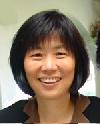

Inducted in 2006
BJ embodied the Intel value of risk-taking when she and her husband moved overseas to broaden her career portfolio. As a result, she was rewarded with fulfilling and highly beneficial leadership and business experience invaluable to her present and future career.
BJ’s innovations and technical leadership have spanned the development of non-volatile memory and microprocessor logic technology. Along the way, BJ has been awarded 13 patents. She has been a presenter and publisher at two of the most significant technical conferences: IEEE and the VLSI Symposium. BJ’s work in the semiconductor industry has enabled Intel to be a technology leader.
Her efforts have resulted in the advancement of devices we use in our everyday lives ranging from personal computers, cell phones, and digital cameras. BJ has been a key contributor to the profound human condition advancement of technology throughout her work in the semiconductor industry.
In 2004, BJ moved back to the United States and rejoined Intel as director of technology integration and development, responsible for driving multiple, leading-edge, non-volatile-memory technologies concurrently with amazing effectiveness. The new business and organization insight she acquired from her China experience has visibly added to her leadership in advancing the organization and the technologies.
In 2002, BJ took a career excursion and joined a new silicon foundry in Shanghai as vice president of technology development. She started from scratch and built a technology development organization and co-led a brand new semiconductor factory startup. She successfully introduced advanced silicon technologies to manufacture a wide spectrum of products ranging from computer chipset, read-only memory (ROM), Flash memory, to random access memories (RAM).
In the 90s and early 2000s, BJ shifted her focus into driving Intel’s microprocessor performance and cost, leading teams to push microprocessor "Gigahertz" clock speed and new generations of silicon technologies.
In 1983, BJ joined Intel as a process development engineer. In BJ’s over 20 years at the forefront of silicon technologies, she concentrated her work on semiconductor technology development. She progressively advanced from an individual contributor role to being a technical manager and now holds the position of director of technology integration in Intel’s Santa Clara development facility.
In the 80s, BJ concentrated on non-volatile technology development and accumulated 13 patents for her work.
BJ is an extremely well-regarded role model among women engineers in Intel. She has amassed a loyal following and has an excellent drawing power among woman engineers and managers. Women engineers looked up to her for her career success, her leadership, her technical ability, and her success in balancing her work and home life. Many come to her for advice, and she readily and unselfishly gives them all help. Her presence, success, and warmth are powerful motivators and inspiration to women engineers who work with or know of her.
BJ’s experience at the forefront of silicon technologies have been instrumental in enabling Intel’s continual achievement to stay on the famous Moore’s Law, and industry mandate, predicted by Intel founder Gordon Moore in the late 60s, to double the miniaturization of silicon devices every two years.
This continual miniaturization and advancement of silicon technology have a profound effect in all of our daily lives, enabling the advancements in every aspect of electronics ranging from personal computers, the internet, cell phones, to everything electronic.
As an immigrant to the United States from conservative Taiwan and as a young adult after college, she had to overcome a language barrier and cultural differences to assimilate into the new land. She chose a male-dominated career and believed she had to work harder and deliver more to secure respect among her male counterparts.
BJ was born and grew up in Taiwan.
She moved to the United States after finishing her bachelor’s degree at National Taiwan University. She earned her PhD in physical chemistry at the University of Southern California.
YouTube
Bloomberg